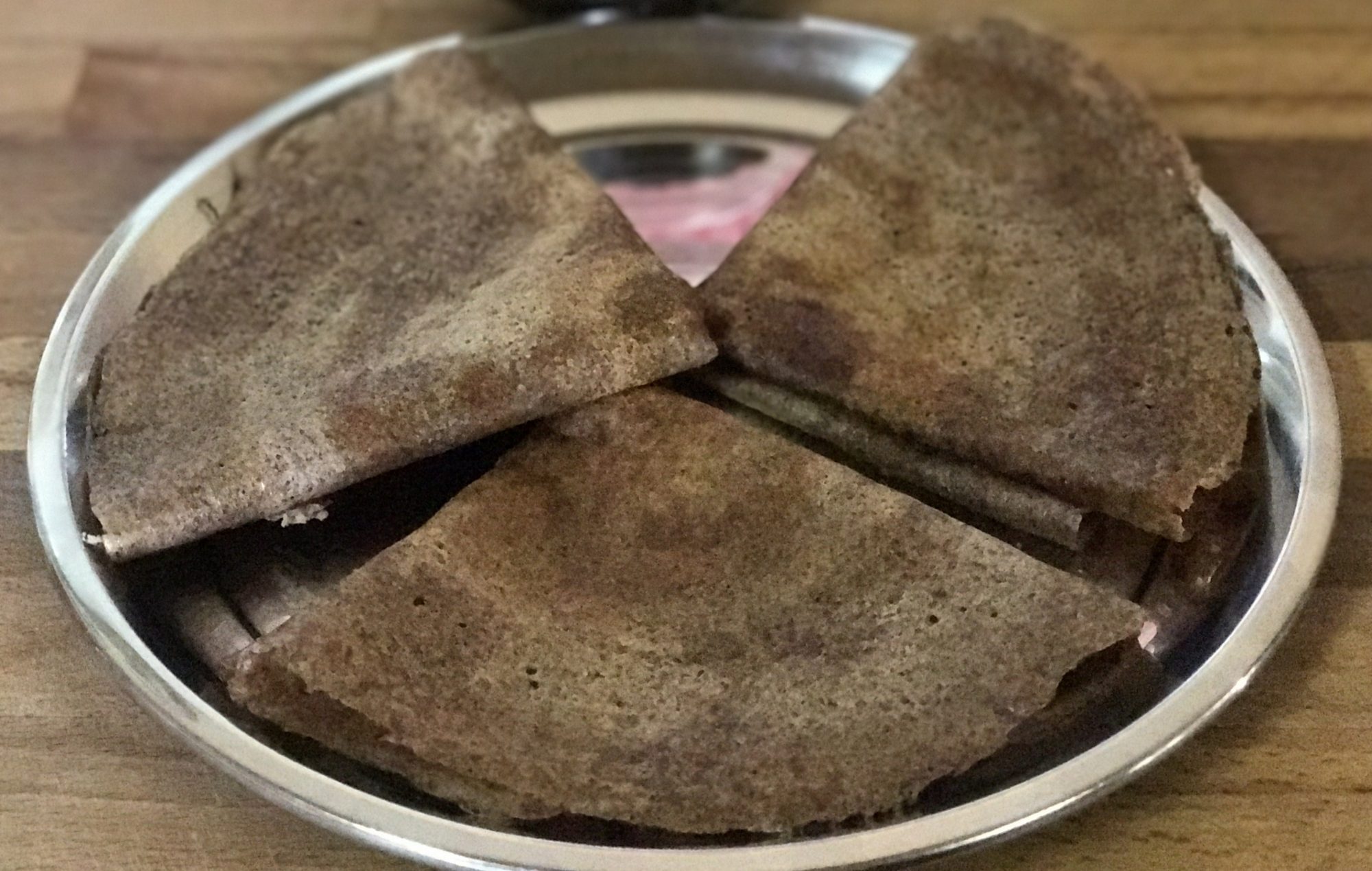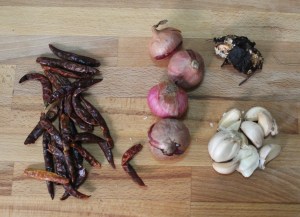It was a lazy sunday morning. But one cannot feel too lazy with a four-year old waiting for food. After a hot cup of ragi kanji/finger millet porridge made with milk (recipe in future), it was time for brunch or a proper lunch. I had made nothing. No special meen kuzhambu/fish curry; no biriyani; no sambhar, no rasam – the usual traditional lunch sequence. (C’mon we need our Sundays too.) Why not something simple yet different; not too time-consuming, but would come under a whole meal category, especially nothing less than expected!
Then came a picture of thuvayal, chicken kuzhambu (chutney/chicken curry) and sivapparisi/brown rice platter!

Mildly spiced Pudhina Kadalai Thuvayal – Mint Peanut Thuvayal doesn’t need seasoning or tempering with mustard seeds and black gram when the thuvayal is served with rice.
What is the difference between thuvayal and chutney? I do not know a definite answer to this. But I have always thought thuvayal is the tamil name for chutney. The thuvayal served as accompaniment for idlies, dosais, uppumas and pongal can be of a little watery consistency. Thuvayal served with rice is a thick paste and a bit coarse too.
The word “chutney” stems from the Sanskrit word chatan, which literally means “to lick.” Chutneys occupy a minuscule spot of real estate on an Indian thali, but an Indian meal would be incomplete without these zingy sides. Not only do chutneys add zing to just about every cuisine in India, but the variations are as abundant as the number of hands that make them! http://poetryoffood.com/stories/bombay-spice/rushina-m-ghildiyal/delicious-chutneys-and-chaats
‘Chutney’ has become a universal term for thick pastes, pickles and sauces, ‘Thuvayal’ has become a term in Tamilnadu, associated more with those chutneys had with rice.
Now, back to our pudhina kadalai thuvayal..
This is a thick thuvayal to be had with steaming hot rice. Generally, thick thuvayal and rice would be had with a combination of a gravy/ kuzhambu or kootu (vegetable and lentil stew). This is for a perfect blend of a thick chutney with a gravy stew for easy consumption and digestion too!
For the gravy dish or kuzhambu to go with rice and thuvayal, I made a quick and easy chicken fillet kuzhambu!

First the thuvayal!
Pudhina Kadalai Thuvayal/Mint-Peanut Thuvayal
Ingredients (serves 4)
- cleaned and washed pudhina/mint leaves – 2 cups
- varutha kadalai/roasted peanuts (with or without skin) – 1/2 cup
- poondu/garlic – 3 cloves
- chinna vengayam/shallots – 6 no.s
- kaayndha milagai/dry red chillies – 3 no.s
- puli/tamarind – gooseberry shaped ball
- oil – 2 tsp
- salt – as needed
- water – a little
Method of Preparation
- Heat oil in an iruppu chatti/pan
- Fry garlic cloves and shallots till garlic cloves become slightly brown and shallots slightly opaque
- Add red chillies and washed tamarind
- Add the mint leaves – mix for a while
- Turn off the stove and let it cool
- Once in room temperature, make a coarse paste with roasted peanuts, salt and water.
Note:
- Usually mint leaves are fried till they shrink. I prefer just before they shrink. This gives a fresh mint smell to the chutney and also the green colour of mint leaves is lost if fried longer.
- Red chillies can be altered according to taste.
- Peanuts can be made to 3/4 cup instead of 1/2 cup if more peanutty taste is preferred.
- Deskinned peanuts are preferred for easy grinding – those who don’t mind the taste of peanut skin can go on with the skin as I do. Saves time and energy in de-skinning.
- Those with peanut allergy – please avoid this recipe.
Peanut skins are also a good source of dietary fiber. Fiber is the part of the plant that is indigestible. It is broken down into soluble and insoluble fiber. Soluble fiber is fermented in the digestive tract and can help lower total cholesterol. Insoluble fiber adds bulk to food and aids in digestion. Peanut skins are a good source of both types of fiber.http://www.livestrong.com/article/98722-nutrients-peanut-skins/
After thuvayal, came kozhi kuzhambu – quick and easy chicken curry. Not a time consuming dish at all.. just keep adding one ingredient after the other to the hot oil in the kadai, close the lid and cook chicken. Simple isn’t it?
Eliya Kozhi Kuzhambu/Quick and Easy Chicken Curry
Ingredients (serves 2)
- chicken fillets – 250 gms
- ginger – small piece
- garlic – 5 cloves
- onions – 2 nos. medium
- tomato – 2 no.s medium
- turmeric powder – 1/2 tsp
- red chilli powder – 1 tsp
- coriander powder – 1 tsp
- garam masala powder – 1 tsp
- salt – to taste
- oil – 4 tsp
- curry leaves – a few
Method of Preparation
- Clean and cut chicken fillets to bite size pieces
- Heat 2 tsp oil in a kadai
- Fry chopped garlic, ginger and onions till slightly brown
- Add chopped tomatoes and fry till soft
- Add all dry powders and salt and fry for a couple of minutes
- Now add chicken pieces and mix well
- Sprinkle very little water and close and cook in medium flame till chicken is done
- With closed lid, chicken would let out water..hence sprinkling little water is enough
- When the chicken is done check salt
- If one finds the gravy too thick, little water can be added
- If one needs a thicker consistency, cook till gravy thickens
- Heat the other 2 tsp oil – preferably gingelly oil (nallennai in tamil) – fry curry leaves and pour into the curry
- Simple Chicken Curry is ready to be served.
Serve thuvayal and kozhi kuzhambu with brown rice. First course of brown rice and thuvayal tastes best with a spoon of hot ghee/clarified butter. To finish the meal, there is always thayir saadham – curd rice.
Thayir saadham – Serve a small ladle of the same cooked brown rice. Mix well with generous amount of curds. This can be had with the thuvayal or chicken curry or as just plain curd rice. Generally it is had with any south indian pickle and/or mor milagai (deep-fried – dried chillies). A south indian meal always ends with thayir saadham – which is rice mixed with curds/yoghurt. This aids in digestion after the intake of varied spices in a lunch and dinner platter.
In my next post, I shall elaborate on the ever-special seasoned thayir saadham!





































